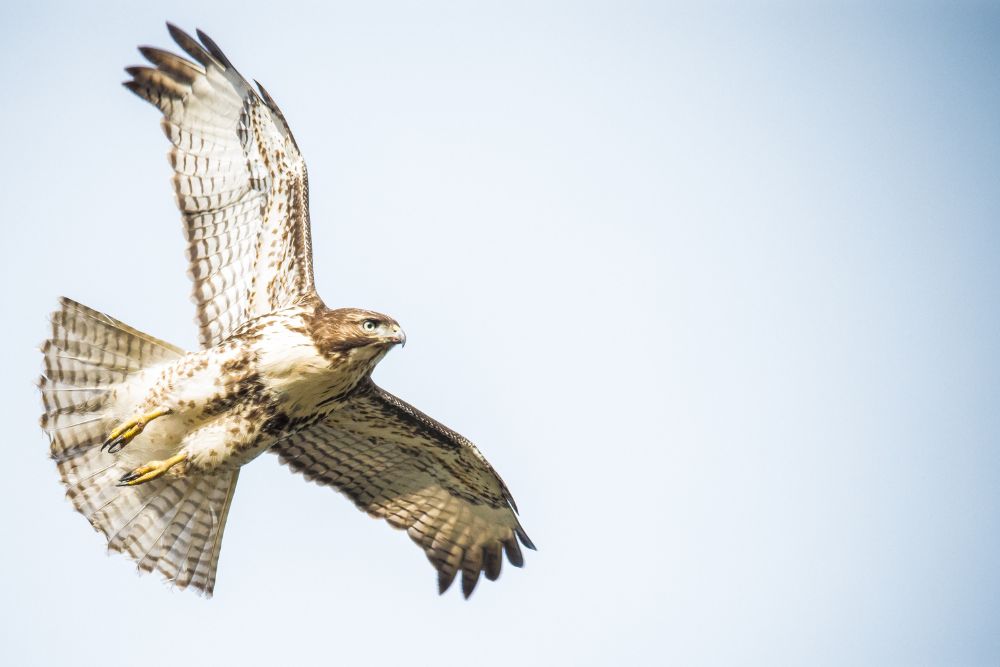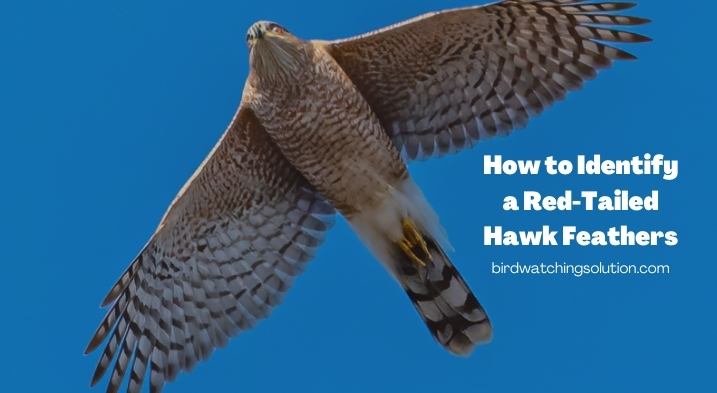Unraveling the Difference Between a Hawk and an Eagle
Are you captivated by the soaring majesty of birds of prey? Hawks and eagles, with their keen eyesight, mighty wings, and predatory prowess, have long held our collective fascination. These majestic hunters dominate the skies with their awe-inspiring displays of agility and grace.
In this comprehensive article, we embark on an exciting journey to unravel the differences between hawks and eagles, shedding light on their distinctive characteristics, hunting strategies, habitat preferences, and more.
Whether you’re a bird enthusiast, nature lover, or simply curious about these magnificent creatures, this article will give you a deeper understanding of their unique traits.
By examining their taxonomy, morphology, flight patterns, and adaptations, we’ll explore how hawks and eagles have evolved to conquer the skies in remarkable ways. Delving into their preferred habitats, geographic distribution, and hunting strategies, we’ll uncover the secrets behind their successful survival and impressive hunting techniques.
But it doesn’t stop there. We’ll also explore their nesting and reproductive behaviors, vocalizations, and cultural significance across various societies. From ancient mythologies to modern symbolism, hawks and eagles have left an indelible mark on human culture and have become enduring symbols of power, courage, and freedom.
So, prepare to be amazed as we embark on this exhilarating journey through the realm of hawks and eagles. Together, we’ll unlock their differences’ mysteries, celebrate their magnificence, and gain a profound appreciation for these majestic hunters that grace our skies.
Join us as we spread our wings and dive into the enthralling world of hawks and eagles!

Taxonomy and Classification
Birds of prey, encompassing hawks and eagles, belong to the order Accipitriformes and the family Accipitridae. Within this family, hawks and eagles are further classified into different genera and species, each with unique traits and adaptations.
Hawks
Hawks, scientifically known as Accipiters, are a group of small to medium-sized birds of prey. They are known for their sharp vision, agile flight, and powerful talons. Hawks are classified into three main genera: Accipiter, Buteo, and Circus. These genera consist of numerous species, each exhibiting specific characteristics.
Shared Characteristics
- Sharp, curved beaks for tearing prey
- Keen eyesight for spotting small prey from a distance
- Broad wings for agile flight and maneuverability
Distinct Features
- Accipiter Hawks: These hawks, including species like Cooper’s hawk and the sharp-shinned hawk, have short, rounded wings and long tails, enabling them to navigate dense forests and ambush prey with swift, surprise attacks.
- Buteo Hawks: This group includes species such as the red-tailed hawk and the rough-legged hawk. Buteo hawks are larger, with broad wings and broad, rounded tails, allowing them to soar for extended periods while searching for prey.
- Circus Hawks: Known as harriers, these hawks, such as the northern harrier, possess long, slender wings and a distinctive facial disk. Harriers are renowned for their low-level flight and hunting technique of gliding low over fields or marshes, searching for small mammals.
Eagles
Eagles, belonging to the genus Aquila, are majestic birds of prey known for their impressive size, strength, and exceptional vision. They are further divided into several species with unique characteristics and habitat preferences.
Shared Characteristics
- Large, powerful beaks for tearing and consuming prey
- Exceptional eyesight for detecting prey from great distances
- Long, broad wings for soaring effortlessly through the skies
Distinct Features
- Aquila Eagles: This genus includes species like the golden and bald eagles. Aquila eagles are renowned for their impressive size, with wingspans reaching over seven feet. They inhabit various habitats, including mountains, forests, and coastal areas, and are skilled hunters capable of taking down relatively large prey.
- Harpy Eagles: Harpy eagles, such as the South American harpy eagle, are known for their striking appearance and powerful build. They have robust bodies, long tails, and strong legs armed with sharp talons. Harpy eagles primarily inhabit tropical rainforests and are skilled hunters of tree-dwelling mammals.
- Sea Eagles: This group includes species like the white-tailed eagle and the Steller’s sea eagle. Sea eagles are well-adapted to coastal environments and have distinctive white tails and heads. They possess a strong flying ability and are adept at hunting fish and waterfowl near bodies of water.
Understanding the taxonomy and classification of hawks and eagles provides a foundation for exploring their fascinating characteristics, behaviors, and ecological roles.
Morphology and Size
Hawks
Hawks exhibit various physical characteristics contribute to their unique hunting abilities and overall appearance. Let’s delve into the morphology of hawks and explore the size variations across different species.
Physical Characteristics
- Sharp, curved beaks: Hawks possess hooked beaks that are specialized for tearing apart their prey.
- Keen eyesight: Hawks have exceptional vision, allowing them to spot their prey from great distances.
- Broad wings: Hawks have broad wings that facilitate agile flight and maneuverability.
- Powerful talons: Hawks have strong, sharp talons to capture and grasp their prey.
Size Range and Variations
Hawks come in various sizes, ranging from small to medium-sized birds of prey. The size variations are evident across different species, and here are some examples:
- Cooper’s Hawk: With a length of approximately 14-20 inches (36-51 cm) and a wingspan of about 28-35 inches (71-89 cm), Cooper’s hawk is considered a medium-sized hawk.
- Sharp-shinned Hawk: This hawk species is relatively smaller, measuring around 9-14 inches (23-36 cm) in length, with a wingspan of about 17-22 inches (43-56 cm).
- Red-tailed Hawk: One of the larger hawks, the red-tailed hawk, measures about 18-26 inches (46-66 cm) in length, with a wingspan of 43-57 inches (109-145 cm).
It’s important to note that these size ranges are approximate, as individual birds may vary within their species.
Eagles
Eagles exhibit striking physical attributes that distinguish them as formidable birds of prey. Let’s explore their morphology and size variations across different species.
Physical Characteristics
- Large, powerful beaks: Eagles possess strong, hooked beaks that allow them to tear into their prey.
- Exceptional eyesight: Eagles have incredibly sharp vision, enabling them to spot prey from great heights.
- Long, broad wings: Eagles have long, broad wings that facilitate efficient soaring and gliding.
- Strong talons: Eagles possess robust talons designed to capture and grip their prey securely.
Size Range and Variations
Eagles are known for their impressive size, and there are notable variations across different species:
- Golden Eagle: This magnificent eagle has a length of approximately 28-40 inches (71-102 cm) and a wingspan ranging from 6 to 7.5 feet (183-229 cm).
- Bald Eagle: The iconic bald eagle is slightly smaller, measuring around 28-38 inches (71-97 cm), with a wingspan of 6 to 7.5 feet (183-229 cm).
- African Fish Eagle: Found in sub-Saharan Africa, this eagle species measures approximately 25-30 inches (64-76 cm), with a wingspan of 6.5 to 8 feet (198-244 cm).
Again, it’s important to note that these size ranges are approximate, as individual eagles may vary within their species.
Flight Patterns and Adaptations

Hawks
Hawks are renowned for their impressive flight capabilities, employing various techniques and adaptations for efficient hunting and aerial maneuvers. Let’s explore the flight patterns and adaptations of hawks.
Flight Patterns
- Soaring: Hawks are skilled soarers, utilizing updrafts and thermal currents to glide effortlessly through the air while conserving energy.
- High-speed diving: Certain hawk species, such as the peregrine falcon, are known for their exceptional diving speeds. They can reach astonishing velocities while descending upon their prey from great heights.
- Agile maneuvering: Hawks possess exceptional agility, allowing them to change directions swiftly and navigate through dense vegetation or intricate landscapes.
Adaptations
- Sharp eyesight: Hawks have keen vision, enabling them to detect prey from high altitudes or while soaring. Their eyes are adapted to focus on distant objects and spot small prey items.
- Aerodynamic body: Hawks have streamlined bodies and long, broad wings, facilitating efficient flight and reducing air resistance.
- Talon strength: Hawks possess strong talons for capturing and grasping prey mid-flight. Their sharp talons ensure a secure grip on the captured prey.
Eagles
Eagles are renowned for their majestic flight and ability to soar effortlessly through the skies. They have developed specialized adaptations for soaring, hunting, and surviving in diverse habitats.
Flight Patterns
- Soaring and gliding: Eagles are masters of soaring and gliding, taking advantage of thermals and air currents to cover large distances with minimal effort.
- Extended flights: Some eagle species, such as the golden eagle, are known for their long-distance flights during migration or while searching for food.
- Aerial displays: Eagles often engage in elaborate aerial displays, showcasing their flying skills and territorial behaviors.
Adaptations
- Broad wingspan: Eagles have long, broad wings, allowing them to catch thermal updrafts and stay aloft for extended periods while minimizing energy expenditure.
- Feather structure: Eagles’ feathers are designed to reduce drag and provide stability during flight, contributing to their graceful aerial movements.
- Powerful beaks and talons: Eagles possess strong, sharp beaks and talons for capturing and dispatching their prey. Their sturdy talons are adapted for gripping and carrying relatively large prey items.
Habitat and Geographic Distribution

Hawks
Hawks display remarkable adaptability to various habitats and have a diverse geographic distribution. Let’s explore their preferred habitats and geographic range.
Preferred Habitats
- Woodlands and Forests: Many hawk species, such as Cooper’s hawk and the red-shouldered hawk, thrive in wooded areas, utilizing the dense vegetation for cover and ambushing prey.
- Open Fields and Grasslands: Some hawks, including the northern harrier and the rough-legged hawk, prefer open landscapes like fields and grasslands, where they can glide low over the ground while hunting for small mammals.
- Urban Areas: Certain hawk species, such as the red-tailed hawk and Cooper’s hawk, have adapted to urban environments and can nest in city parks or suburban areas.
Geographic Distribution
Hawks are distributed widely across different regions, including:
- North America: Many hawk species are found throughout North America, from the northern regions down to Mexico.
- Europe: Various hawk species inhabit European countries, with some species extending into Asia.
- Africa: Hawks can be found in different habitats across Africa, including savannas, woodlands, and mountainous regions.
- Asia: Hawk species have a diverse presence across the Asian continent, adapting to various ecosystems from deserts to forests.
- Australia: Australia is home to several unique hawk species adapted to its distinct environments, such as the black-breasted buzzard.
Eagles
Eagles exhibit specific preferences for certain ecosystems and have distinctive geographic distributions. Let’s explore their preferred habitats and geographic range.
Preferred Habitats
- Mountainous Regions: Many eagle species, such as the golden eagle and the Steller’s sea eagle, are well-suited to mountainous terrains, where they build their nests and hunt in alpine environments.
- Coastal Areas and Wetlands: Several eagle species, including the bald eagle and the African fish eagle, are associated with coastal areas, estuaries, and wetlands, where they can find abundant prey, particularly fish and waterfowl.
- Tropical Rainforests: Some eagle species, like the harpy eagle and the Philippine eagle, are specialized for life in dense tropical rainforests, preying on arboreal mammals and birds.
Geographic Distribution
Eagles are distributed across various regions and continents, including:
- North America: The bald eagle, a prominent eagle species, has a significant presence in North America, particularly near water bodies and along coastlines.
- Eurasia: Golden eagles have a broad geographic range, inhabiting Eurasian countries, including the mountains of Europe, Asia, and parts of the Middle East.
- Africa: Several eagle species, such as the African fish eagle and the martial eagle, can be found across different African countries, occupying a range of habitats from wetlands to savannas.
- Australia: Australia is home to unique eagle species like the wedge-tailed eagle, which is adapted to the country’s varied landscapes, including deserts, grasslands, and woodlands.
Hunting Strategies and Prey Preferences
Hawks
Hawks employ various hunting strategies and techniques to capture their prey. Let’s delve into their hunting strategies and preferred prey.
Hunting Strategies
- Ambush Predation: Hawks like Cooper’s hawk and the sharp-shinned hawk are adept at ambush predation. They use their agility and speed to surprise their prey, often launching surprise attacks from concealed perches or dense vegetation.
- High-speed Pursuit: Some hawk species, such as the peregrine falcon and the merlin, are known for their exceptional aerial speed. They engage in high-speed pursuits, diving from great heights to capture their prey in mid-air.
- Contour Hunting: Hawks like the red-tailed hawk and the Swainson’s hawk engage in contour hunting, soaring at low altitudes while scanning the ground for small mammals or reptiles.
Prey Preferences
Hawks have diverse prey preferences, which vary depending on their size, habitat, and hunting strategies. Their prey can include:
- Small mammals: Hawks often prey upon small mammals such as mice, voles, rabbits, and squirrels.
- Birds: Certain hawk species, like the Cooper’s and sharp-shinned hawks, primarily target smaller birds.
- Reptiles and Amphibians: Hawks may also hunt reptiles and amphibians, including snakes, lizards, and frogs.
Eagles
Eagles employ specific hunting strategies and techniques to capture their prey. Let’s explore the hunting strategies and preferred prey of eagles.
Hunting Strategies
- Scanning and Soaring: Eagles are skilled at scanning large areas from elevated perches or soaring high above. Once they spot potential prey, they descend swiftly to capture it.
- Fishing: Some eagle species, such as the bald eagle and the African fish eagle, have a specialized hunting technique known as fishing. They swoop to snatch fish from the water’s surface using their sharp talons.
- Carrion Feeding: Eagles, including the bald eagle, are opportunistic scavengers and may feed on carrion, taking advantage of available food sources.
Prey Preferences
Eagles exhibit a wide range of prey preferences, depending on their habitat and feeding strategies. Their preferred prey may include:
- Fish: Many eagle species, such as the bald eagle and the white-bellied sea eagle, are highly skilled at capturing fish from lakes, rivers, and coastal areas.
- Birds: Eagles may prey upon various bird species, including waterfowl, seabirds, and smaller birds found in their respective habitats.
- Small Mammals: Some eagle species, like the golden eagle, may hunt small mammals such as rabbits, hares, and ground squirrels.
Nesting and Reproduction

Hawks
Hawks exhibit fascinating nesting behaviors and follow a unique reproductive cycle. Let’s explore their nesting habits, courtship rituals, and parental care.
Nesting Behaviors
- Nest Construction: Hawks build nests using twigs, branches, and other materials, usually situated in the forks of trees or on cliffs. The nests are often large and sturdy, providing a secure breeding and nesting site.
- Nest Site Selection: Hawks select nesting sites with suitable food sources and good visibility to monitor their surroundings.
- Nest Reuse: Many hawk species, such as the red-tailed hawk, reuse their nests year after year, making necessary repairs and additions.
Reproductive Cycle
- Courtship Rituals: Hawks engage in courtship displays that involve aerial acrobatics, soaring together, and calling to attract a mate.
- Egg Laying and Incubation: After courtship, the female hawk lays a clutch of eggs in the nest. The incubation period varies among species but generally lasts several weeks. The male and female take turns incubating the eggs.
- Parental Care: Both parents care for the nestlings once the eggs hatch. They provide food and protection, regurgitating prey for the young until they can feed themselves.
- Fledging and Independence: As the nestlings grow, they develop flight feathers and eventually fledge from the nest. The parents provide food and guidance until the young hawks become independent.
Eagles
In contrast to hawks, eagles also have distinct nesting and parenting behavior which is explained in detail below:
Nesting Behaviors
- Large Nests: Eagles construct large nests, called eyries or aeries, using branches, sticks, and other materials. Their nests can reach impressive sizes and are often refurbished and added to each breeding season.
- Nest Placement: Eagles typically choose high, sturdy locations for their nests, such as tall trees, cliffs, or rocky outcrops, providing a vantage point for hunting and protection.
- Nest Site Fidelity: Eagles often exhibit nest site fidelity, returning to the same nesting site year after year, sometimes even using the same nest structure.
Reproductive Cycle
- Elaborate Courtship Displays: Eagles engage in captivating courtship displays, which can involve soaring together, aerial acrobatics, and vocalizations.
- Egg Laying and Incubation: The female eagle lays one to three eggs in the nest after courtship. Incubation begins once the first egg is laid, and both parents take turns incubating the eggs. The incubation period varies among eagle species but typically lasts several weeks.
- Parental Care: Once the eggs hatch, both parents feed and protect the nestlings. They provide food, often brought by the male, and offer warmth and protection. The parents continue caring for the young eagles until they become independent and capable of hunting.
- Juvenile Development: As the young eagles grow, they undergo plumage changes and develop their flight muscles. They practice flight skills near the nest, gradually gaining strength and agility before venturing further away.
Vocalizations and Communication
Hawks
Hawks utilize various vocalizations and communication methods to express themselves and communicate with other individuals. Let’s explore the vocalizations and communication methods of hawks.
Vocalizations
- Calls: Hawks produce a range of calls that serve different purposes. These calls can include sharp, high-pitched screams, screeches, or raspy cries. The specific calls vary among species and can convey aggression, territoriality, or alarm.
- Mating Calls: During the breeding season, male hawks may emit specific calls to attract females and establish their presence in a territory.
- Juvenile Calls: Young hawks produce distinct vocalizations, such as begging calls and seeking food from their parents.
Communication Methods
- Body Language: Hawks use various body postures and movements to communicate with other hawks. These can include wing displays, head tilting, or fluffing of feathers, indicating aggression, territorial defense, or courtship behavior.
- Flight Patterns: Hawks also communicate through their flight patterns. They may engage in aerial displays, such as aerial courtship rituals or territorial flights, to convey messages to other nearby hawks.
Eagles
Eagles’ distinct vocalizations and communication methods are crucial in their social interactions and behaviors. Let’s uncover the vocalizations and communication methods of eagles.
Vocalizations
- Calls: Eagles produce a variety of calls that can range from high-pitched whistles to loud, piercing cries. These calls serve different purposes, including territorial defense, courtship displays, and communication between mates.
- Alarm Calls: Eagles emit alarm calls when they perceive potential threats or intruders in their territory, alerting other eagles to danger.
- Juvenile Calls: Young eagles have unique vocalizations, such as begging calls and requesting food from their parents.
Communication Methods
- Visual Displays: Eagles use visual displays to communicate with each other. These displays include wing flapping, aerial acrobatics, head movements, conveying dominance, submission, or courtship intentions.
- Talon Locking: In some eagle species, individuals may use talon locking during territorial disputes or as part of their courtship rituals. This behavior serves as a visual communication of strength and determination.
Cultural Significance and Symbolism
Hawks
Hawks hold significant cultural symbolism and have been revered in various mythologies, folklore, and art forms. Let’s delve into the cultural significance and symbolism associated with hawks.
Mythology and Folklore
- Spiritual Messengers: In several Native American traditions, hawks are believed to be spiritual messengers between humans and the divine realm, carrying messages and providing guidance.
- Symbol of Strength and Vision: Hawks are often associated with strength, keen eyesight, and focus. They symbolize clarity of vision, intuition, and the ability to perceive opportunities or dangers.
- Guardians and Protectors: In some cultures, hawks are seen as protective spirits or guardians. They are believed to watch over individuals or specific territories, offering guidance and protection.
Art and Symbolic Representations
- Artistic Depictions: Hawks have been depicted in various forms of art, including paintings, sculptures, and jewelry, symbolizing their grace, power, and connection to the natural world.
- Heraldic Symbolism: Hawks are sometimes featured in heraldry, representing qualities such as courage, nobility, and vigilance. They can be found on coats of arms, crests, and flags of different families, organizations, or regions.
Eagles
Eagles have deep cultural significance and symbolism in many societies, often associated with power, majesty, and national pride. Let’s explore the cultural significance and symbolism attributed to eagles.
Cultural Roles
- National Symbols: Eagles hold great significance as national symbols in numerous countries, representing strength, freedom, and sovereignty. Examples include the bald eagle in the United States and the golden eagle in Germany.
- Spiritual and Mythological Significance: Eagles are revered in various spiritual and mythological beliefs. In many cultures, they symbolize divine grace, wisdom, and a connection to the celestial realm.
- Heroic and Noble Traits: Eagles are often associated with heroic qualities such as courage, leadership, and resilience. They represent nobility and are seen as symbols of honor and nobility.
Heraldry and Representations
- Heraldic Symbolism: Eagles are prominently featured in heraldry, symbolizing power, bravery, and nobility. They can be found on coats of arms, national emblems, and flags, signifying a nation’s identity and values.
- Artistic Representations: Eagles have been depicted in various art forms throughout history, including paintings, sculptures, and decorative motifs. These artistic representations highlight their majestic beauty and cultural significance.
Conservation Status and Threats
Hawks
Hawk species face conservation challenges, and their populations are affected by various threats. Let’s assess the conservation status of hawks, discuss the threats they face, and examine the conservation efforts in place.
Conservation Status
- Species at Risk: Some hawk species, such as the red-shouldered hawk and the northern goshawk, are classified as species of conservation concern due to declining populations or habitat loss.
- Endangered and Threatened Species: Certain hawk species, like the Hawaiian hawk or the Mauritius kestrel, are listed as endangered or critically endangered due to habitat destruction, pollution, and human activities.
Threats and Conservation Efforts
- Habitat Loss: Hawks are impacted by habitat loss due to urbanization, deforestation, and conversion of natural habitats for agriculture. Loss of suitable nesting sites and decreased prey availability pose significant challenges.
- Illegal Hunting and Trade: Some hawk species are targeted by illegal hunting, capturing, or trading for falconry or the pet trade, which further endangers their populations.
- Conservation Initiatives: Efforts are being made to protect and conserve hawk species through habitat preservation, captive breeding programs, and public awareness campaigns to reduce illegal hunting.
Eagles
Eagle species face conservation concerns and various threats that impact their populations. Let’s evaluate the conservation status of eagles, shed light on the challenges they encounter, and explore ongoing conservation initiatives.
Conservation Status
- Threatened Species: Several eagle species, such as the Philippine eagle and the African fish eagle, are classified as threatened due to habitat loss, hunting, and pollution.
- Vulnerable Populations: Habitat degradation, disturbance, and electrocution from power lines have led to the decline of certain eagle populations, including the Spanish imperial eagle and the Steller’s sea eagle.
Challenges and Conservation Efforts
- Habitat Destruction: Eagles face habitat loss and fragmentation, primarily due to deforestation, urban expansion, and land conversion. Destruction of their nesting sites and foraging areas threatens their survival.
- Illegal Wildlife Trade: Some eagle species, prized for their feathers, parts, or pets, are targeted by illegal wildlife trade, posing a severe threat to their populations.
- Conservation Programs: Conservation initiatives involve habitat protection, restoration projects, captive breeding programs, and collaboration with local communities to raise awareness and mitigate threats to eagle populations.
Conclusion
Throughout this article, we have delved into the captivating world of hawks and eagles, uncovering the remarkable attributes and unique characteristics that define these magnificent birds of prey.
From their taxonomy and morphology to their flight patterns, hunting strategies, and nesting behaviors, hawks and eagles showcase diverse adaptations and behaviors that enable them to thrive in various environments.
We explored their preferred habitats, geographic distribution, and the importance of preserving these ecosystems to ensure their survival. We also discussed their vocalizations, cultural significance, and symbolism, deeply embedded these birds into our mythology, folklore, and artistic representations.
However, as we delved into their world, we also became aware of the conservation challenges and threats they face. Hawks and eagles encounter habitat loss, illegal hunting, pollution, and other human-induced factors that impact their populations.
We must recognize the significance of these birds and take proactive measures to conserve their habitats and protect their populations.
By understanding the unique attributes, ecological roles, and cultural importance of hawks and eagles, we can foster a deeper appreciation for these remarkable creatures. Let us support conservation efforts, advocate for sustainable practices, and raise awareness about protecting these majestic birds and their habitats.
As we gaze upon the skies, let us be reminded of the grace, power, and resilience exemplified by hawks and eagles, and may our collective efforts ensure their presence for generations to come.






